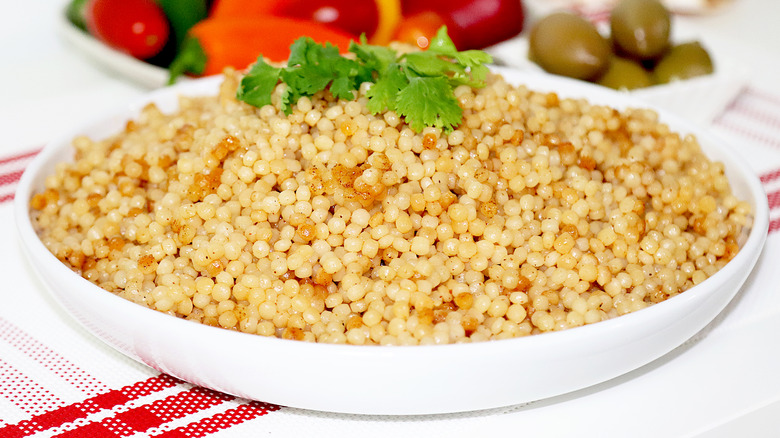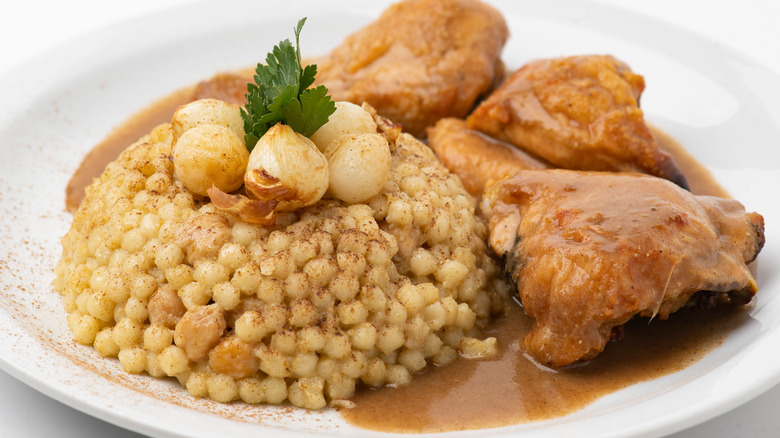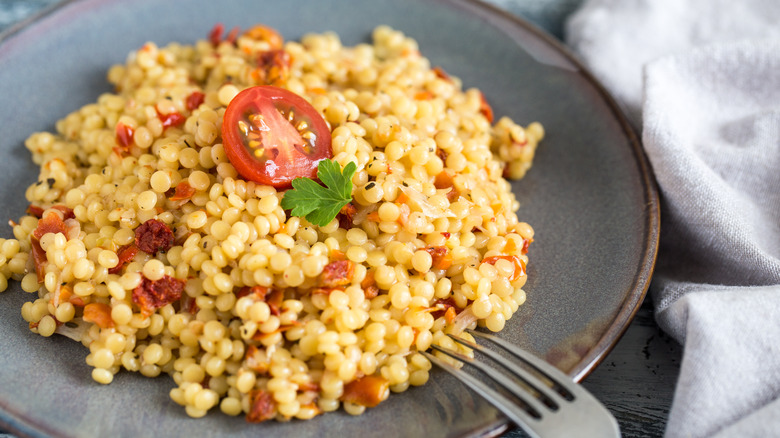The Difference Between Israeli And Lebanese Couscous
Rice may always be the most beloved pantry staple, but fluffy couscous is finally receiving some of the spotlight. Made from processed semolina, the fluffy food is actually a type of pasta, rather than a grain. Hailing from Northern Africa, couscous later spread around the Arab world, and into the Middle East. Today it's divided into three types — Moroccan couscous, Israeli couscous, and Lebanese couscous.
And although Israel and Lebanon may be neighbors, their couscous styles are distinct. Lebanese couscous is the largest of all varieties, similar in both size and color to a chickpea. It has a tinge of nuttiness, along with a chewy texture. Its heartier nature makes it more similar to acini de pepe than a fluffy couscous type.
Conversely, Israeli couscous is smaller and shaped like a peppercorn. Its mouthfeel is less pasta-like and more akin to barley, with pleasant chewiness. Since it's toasted before preparation, it has a pleasant savory note. Both varieties have distinct culinary usage — let's dive into the details.
How to cook with Lebanese couscous
As the starchiest type, Lebanese couscous necessitates a long and slow cooking duration. It's typically boiled with a precise ratio of water, alongside flavorings like salt and caraway. It takes 20 minutes for the pasta to come together. Afterward, it's fluffed with a fork.
In Lebanon, it's most classically prepared in a dish called Moghrabieh, a rich and flavorful chicken stew. In fact, the namesake refers to both the recipe and the couscous varietal itself. Moghrabieh comes together with chickpeas and shredded chicken submerged in a spiced broth, which is spooned over the prepared couscous.
Lebanese couscous is also paired with chickpeas in a refreshing salad, alongside olives, tomatoes, cucumbers, and herbs. A dish similar to herby tabouli, the thicker couscous pearls give the refreshing recipe a heartier take. Alternatively, pair it with a cooked savory green like sautéed kale. Pair bold flavors with Lebanese couscous; since it has a mild nutty flavor, it should be more of a textural centerpiece.
Utilize Israeli couscous in many applications
Israeli couscous also takes some time on the stove, although not as long as the Lebanese variety. It can be prepared like other pasta, thrown into boiling water for eight minutes, and then drained. Alternatively, it can also be steamed for 10 minutes in a measured amount of water like other couscous varieties.
The couscous's toasted flavor is its quintessential characteristic. This quality can be heightened by further toasting the couscous in olive oil. Such a gentle flavor combined with its size makes Israeli couscous highly malleable to varying palettes. Align with savory notes by combining the couscous with garlic, mushrooms, wine, and herbs into a risotto-like dish. Or take it in a tangy direction by making a refreshing salad with cucumbers and tomatoes. It can even be a hearty component in a chicken soup, or a filler in stuffed bell peppers. With a firm texture, it integrates well into a wide range of applications.


